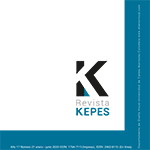Authors
Abstract
This article focuses on the analysis of transversality as a characteristic element in the use of color as a plastic-sign in visual images allowing a more complete narrative in the different versions and uses of color in the same topic. To achieve this objective, the classic story Snow White and the Seven Dwarves is used as a reference showing the different uses of color in the story and their transversality. This analysis is part of the research project “Color as a narrative means in the illustration of classic stories: Snow White and the Seven Dwarves and Alice in Wonderland” where color is worked as a plastic sign and therefore with narrative value within the visual images which aims to identify the characteristics and color features that allow a visual narrative. In order to go deeper into the subject, one of the points worked focuses on the transversality of color from the text to the image, where it is intended to establish if there is a relationship between the use of color in the writings of the classic stories and the use of color as a plastic sign in the images resulting from them. This analysis was carried out through dialogue with authors of the medium and bibliographic analysis which resulted in an approach to the concept of transversality of color as one of the characteristics that determines the narrative character of color in visual images. This could be the basis for deepening the analysis and use of color as a plastic sign and, therefore, a narrative entity in the visual arts.
References
Batchelor, D. (2000). Chromophobia. Reaction Books. London.
Becerra, J, Cotino Hueso, L., León, I.P., Sánchez-Acevedo, M.E., Torres Ávila, J. y Velandia Vega, J. (2018). Derecho y big data. Bogotá: Editorial Universidad Católica de Colombia
Berenger P. (Productor). (2012). Blancanieves. 1.35min. De https://www.youtube.com/watch?v=S9r_CZIQKwA.
Bettelheim, B. (2012). Psicoanálisis de los cuentos de hadas (Booket.divulgación, 3306). Barcelona: Editorial Crítica.
Becerra, J, Hernández, J y Pérez, N. (2019). Enseñando la Ley de Transparencia y acceso a la información pública con la ayuda de recursos electrónicos,331-342 ,Barcelona: Universitat Oberta de Catalunya, Huygens Editorial.
Carrere, A. y Saborit, J. (2000). Retórica de la pintura (Signo e imagen, 59). Madrid: Cátedra.
Gaster, M. (1931). Book review: The pentamerone of Giambattista Basile. Folklore, 42(4), 496-500.
Chirimuuta Mazviita 2017 Outside Color, Perceptual Sience and the Puzzle of color in Philosophy. The MIT Press, Cambridge, Massachusetts
Gombrich, E. (1994). Historia del arte. Barcelona, España: Ediciones Garrig.
Groupe μ. (1993). Tratado del signo visual: para una retórica de la imagen. Madrid: Cátedra.
Grimm, J. & Grimm, W. (1976). Cuentos / Jacob y Wilhelm Grimm, trad. Pedro Gálvez. Madrid: Alianza Editorial.
Grupo Mañana. (2016). Psicología Teórica, Neuropsicología del Color. Universidad de Granada.
Harthan, J. (1981). The history of the illustrated book. The western tradition. Thames and Hudson.
Heller, E. (2000). Psicología del color. Cómo actúan los colores sobre los sentimientos y la razón. Barcelona: Gustavo Gili.
Lee, K., Foster, J., & Giles, R. (1968). Illustrators of children's Books 1957-1966. Boston: the horn book,INC.
Mavor, C. (2017). Aurelia: Art and Literature through the Mouth of the Fairy Tale London: Reaktion.
Nikolajeva, M. (2014). Retórica del personaje en la literatura para niños. México: Fondo de Cultura Económica.
Otálora K., & Hernández J. (2018). ARTE Y DERECHO: DE LA PALABRA DEL PÜTCHIPÜ’ÜI A LA IMAGEN. Novum Jus, 12(1), 221-244. https://doi.org/10.14718/NovumJus.2017.12.1.9
Propp, V. (1984). Las raíces históricas del cuento (Cuarta edición. ed., Colección arte. serie crítica, 50). Madrid: Editorial Fundamentos.
St. Clair, K. (2016). The secret lives of color. New York: Penguin Books.
Zipes, J. (2014). El irresistible cuento de hadas: historia cultural y social de un genero. Ciudad Autónoma de Buenos Aires: Fondo de Cultura Económica.

 PDF (Español)
PDF (Español)
 FLIP
FLIP





















